During production earthworks it is necessary to carry out a number of side works, without which development is impossible. These works are called auxiliary.
The most common auxiliary works during excavation work include:
- installation of fastenings for trenches and pits;
- drainage (removal of water from pits);
- construction of temporary roads, entrances to and exits from the mine face for transporting soil during its development.
We must always strive to ensure that all auxiliary work is carried out by special workers and that the performance of auxiliary work does not delay or interfere with the main work.
Pit fastening device
As already indicated in, not every soil can support vertical slopes when digging. The magnitude of the required pit slope is equal to the magnitude of the angle of natural repose of the soil. This slope is the most reliable.
However, digging pits and trenches at great depths with gentle slopes is considered uneconomical, as it causes a significant amount of unnecessary excavation work. Even at shallow depths, natural slopes are sometimes impossible to achieve, for example, if buildings are located nearby. In those cases when the bottom of a pit or trench is under water, free slopes are completely unacceptable, since they are not protected in any way from soaking by water and destruction.
This is why, in most cases, when constructing pits and trenches, it is necessary to arrange various kinds of temporary fastenings. In addition, as indicated above, a special type of fastening (sheet piling) serves to reduce the inflow into the pits groundwater.
Fastening trenches and pits with wooden spacers
The simplest fastenings to the walls of pits and trenches up to 2 m deep are arranged as follows.
Along the walls of the trenches, 4 boards 50 mm thick are laid with spacers between them, placed every 1.5-2 m along the length of the trenches (Fig. 38);
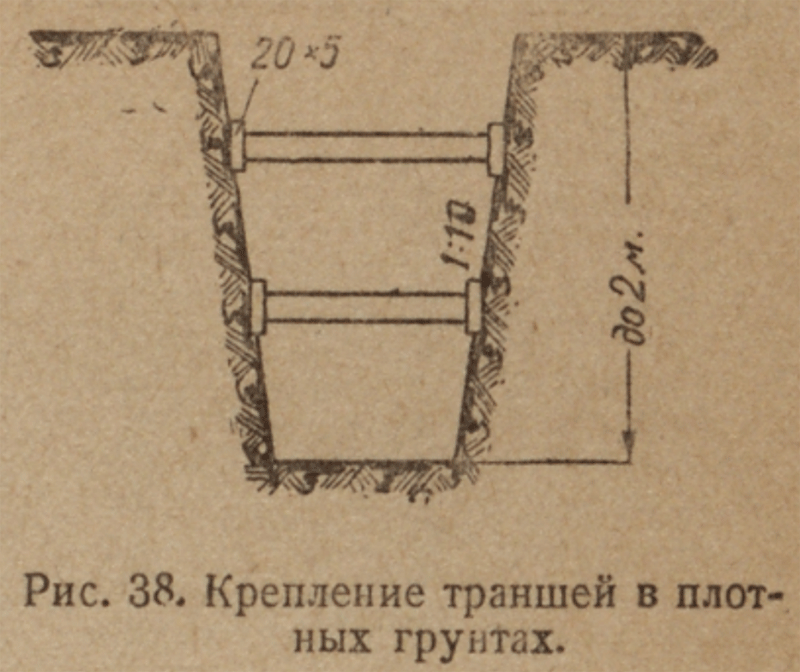
Spacers are made from short logs or pipes 10-12 cm thick. This type of fastening is used for dense, dry soils that can hold a vertical slope for some time and are not washed away by rain (dense clay, dense loam). In this case, the slopes can be either vertical or with a slight slope (1/10).
At greater depths (up to 4 m) for dry soils that give rise to local sliding within a short period of time after lifting, a so-called horizontal fastening is installed. It is arranged like this: a series of thrust posts made of boards up to 6 cm thick or plates are installed over the entire depth of the pit at a distance of 2 to 3 m, depending on the depth of the pit (Fig. 39). Behind these posts, a fence is laid from horizontal rows of boards 4-5 cm thick, staggered or continuous, depending on the ground. Wooden or steel spacers are used to hold the posts in place. The spacers should have a length slightly greater than the distance between the opposite walls. When installing a spacer, this circumstance makes it possible to “start” the spacers with blows of a sledgehammer or hammer, and thereby tightly press the posts and fence against the walls of the pit or trench.

To prevent the spacers from falling (Fig. 40), short pieces (bobs) made from scrap boards 4-5 cm thick are placed under their ends. The short pieces are nailed to the posts with 125 mm nails.
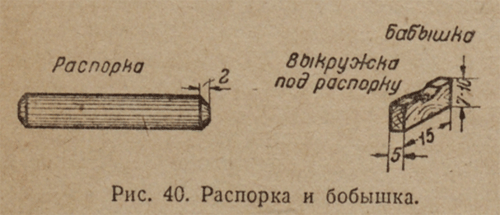
The distance between the spacers in height depends on the depth of the trench. As the depth increases, the pressure of the soil on the fastenings increases, so spacers are placed at the bottom more often than at the top, namely: at the top - after 1.2 m and at the bottom - after 0.9 m in height. The upper horizontal board is placed slightly higher than the edge of the trench so that the soil from the edge does not fall into the trench. To transfer the soil, shelves made of boards are laid on spacers.
For loose and wet soils, as well as crumbling soils, vertical fastening is used, which differs from horizontal fastening in that horizontal boards it is replaced by vertical, and the racks - by horizontal pressure bars. The pressure bars are pushed apart by spacers from the knurl, forming spacer or pressure frames (Fig. 41).
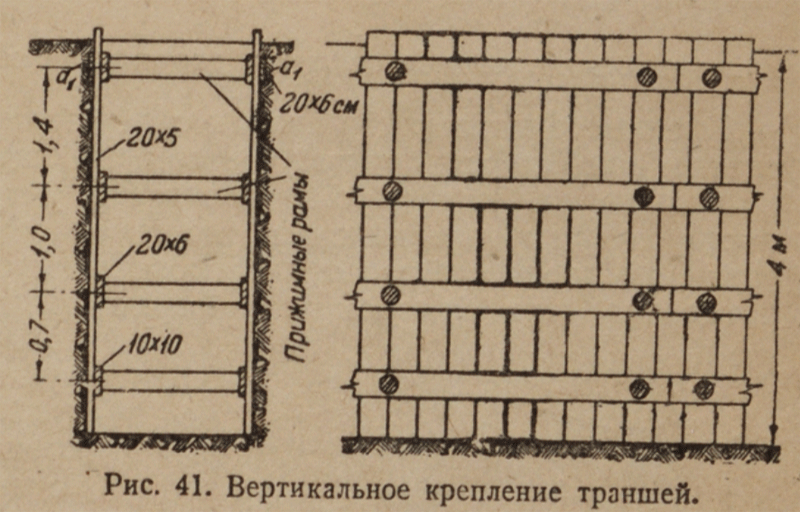
Clamping frames for vertical fastening to a depth of up to 3 m are made of semi-edged boards 6 cm thick, and spacers are made of knurling or plates. At a depth of up to 6 m, the thickness of the pressure boards, as well as the spacer, should be increased to 10 cm.
In addition to the inner board, the upper clamping frame must also have an outer board 6 cm thick. This board cuts into the trench wall to its full thickness.
The height distance between individual clamping frames made of boards is 0.7 - 1.0 m, and with frames made of plates and beams - 1.0 - 1.4 m.
At a depth of up to 5.0 m, the number of spacers for each frame made of boards 6.5 m long is 4 pcs., at greater depths - 5 pcs.
For both vertical and horizontal fastening, the trench walls must be plumb. With inclined walls, the spacers can pop up under the pressure of the earth.
The lower clamping bars and spacers for fastening water supply and sewer trenches must be positioned in such a way that there is a gap between them and the bottom of the trench sufficient for unhindered laying of pipes.
There are often cases (weak soil, presence of water) when fastenings are necessary before digging begins. In these cases, the fastenings are more complex.
Such fastenings include:
Bottomhole fastening
In small but deep pits and pits, the so-called downhole fastening is used (Fig. 42).
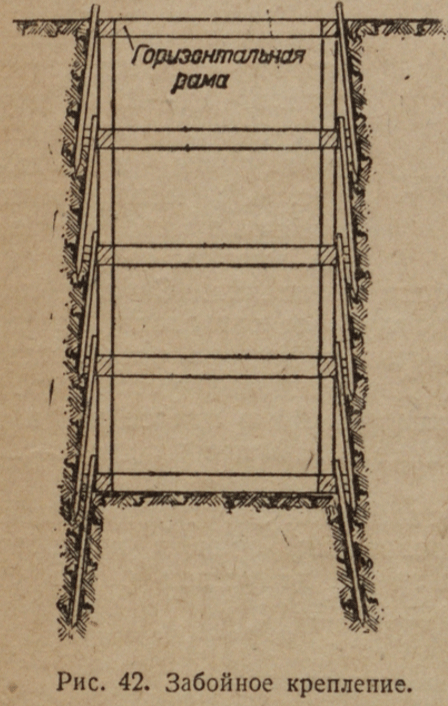
It is arranged as follows: on the surface of the earth at the location of the pit or pit, a horizontal cobblestone frame is laid according to the size of the pit. This frame is buried flush in the ground, after the frame a row of boards is driven in slightly at an angle. Then they begin to dig a pit under the protection of the walls formed by boarded boards. When the excavation approaches the lower ends of the forgotten boards, a second frame is placed between them. To ensure that the upper frame does not fall down as the soil is excavated, short bars made of bars that are gradually lengthened are placed under it. When the second frame is installed, bars are installed between it and the upper frame, which support the upper frame. Next, another row of slightly sloping boards is nailed along the outer edge of the bottom frame. Between the upper and lower rows of the fence, wedges for greater stability of the upper fence are driven in.
Fastening pits with piles with a wooden fence between them
Fastening pits with piles with a wooden fence is used in weak soils that do not allow digging a pit to its full depth. In addition, the installation of transverse struts when fastening a pit is often undesirable, since it complicates the work in the pit. If the pit is large or its shape is complex, it is generally impossible to install spacers. Therefore, in all such cases, they resort to fastening with piles with wooden filling between them. This type of fastening is as follows: before digging begins, wooden and sometimes steel (iron) piles, the so-called lighthouse piles, are driven into the ground at a distance of 1.5-2 m from each other, depending on the depth of the pit (Fig. 43) ; Between these piles, as the excavation deepens from the side of the slope, separate fastening boards are laid. Piles are driven to a depth somewhat greater than the depth of the pit, so that until the end of digging the pit, the pile remains sufficiently stable. To enhance the stability of lighthouse piles, their upper ends are anchored in the slope or supported by struts, resting the latter on the piles driven into the bottom of the pit.
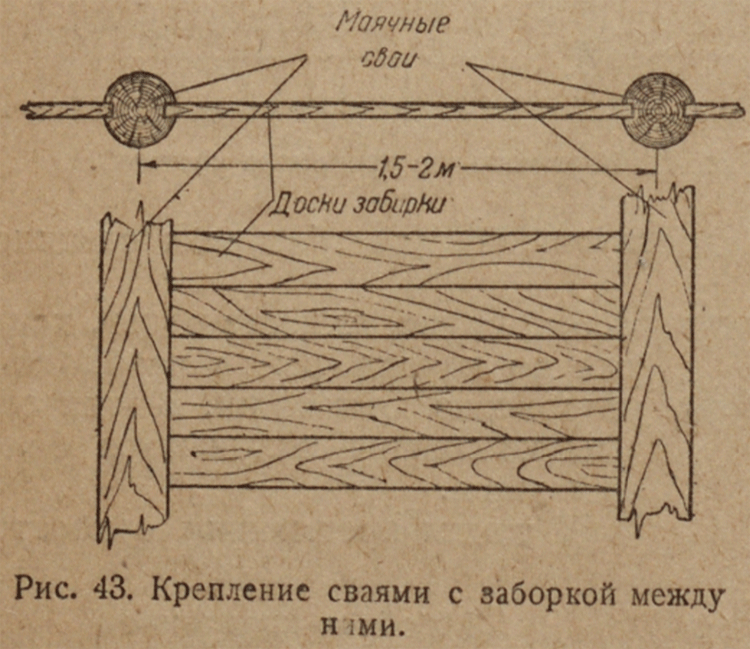
Fastening pits with piles with a fence can also be installed in pre-dug pits, if it is undesirable to have spacers in the pit, and the soil allows digging without pre-installed fastenings.
Fastening with sheet piles
To secure pits in soils saturated with water (slurry and quicksand), the so-called sheet piling is used. Sheet piling consists of a continuous row of vertically installed sheet piling pipes or boards (in which a tongue-and-groove is made on one edge and a ridge on the other), pressed against the walls of a trench or pit by horizontal frames with spacers (Fig. 44). Everything that has been said about spacers in vertical fastening applies entirely to sheet piling fencing; the thing is that with sheet piling, the sheet pile is first driven in, and then a trench is dug with the spacer frames being gradually installed; in a vertical fastening, a trench or foundation pit is first dug, and then a fastening is installed, which is gradually lowered down as the soil is further excavated. The sheet pile boards are driven to a depth slightly greater (0.2-0.5 m) than the depth of the trench or pit, so that after digging is completed, their lower ends cannot be moved by the pressure of the soil.
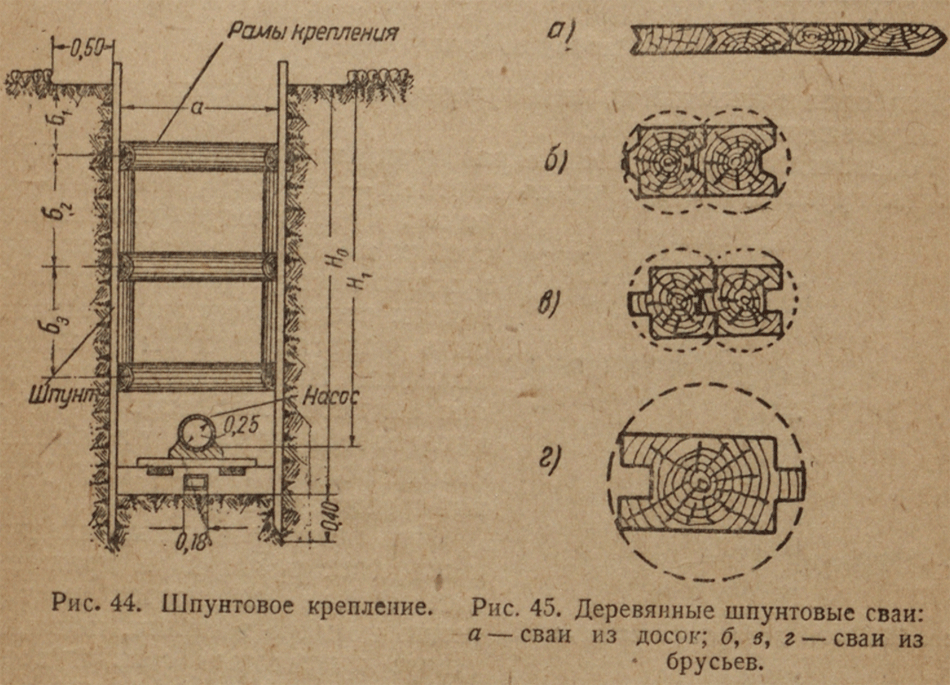
Wooden tongue and groove is made from boards 6-7 cm thick or from beams 10x20 cm (Fig. 45). A tongue and groove are installed in each sheet piling (pile). When driving piles, the ridge of one fits into the groove of the other. The cutting of the lower end of the pile is made in the form of a wedge with an acute angle on the groove side. With this type of driving, the piles fit tightly to each other when driving, which is very important in wet soils, when water seeps under pressure into the cracks of loose sheet piles. Sheet piles must be made from raw, freshly cut wood. If they are made from wood that has been lying in the air for some time, then before driving they must be placed in water for 10-15 days so that they have time to swell. This is done because the sheet piling row, driven from dried piles, swells in wet soil and, due to the increase in the volume of the piles, the row bends; individual piles are turned out, forming cracks, and the row becomes unusable. the work of driving piles begins with the installation of a row of so-called lighthouse piles exactly along the line of the future, 2 m apart from each other (Fig. 43).
These piles are driven first and frame beams are attached to them on both sides. In the spaces between the lighthouse piles and the frame beams that serve as guides, the remaining piles of the sheet piling row are driven. Each subsequent pile must be adjacent to the one already driven into the groove, and the ridge must remain free, otherwise the grooves will become heavily clogged with earth, and it will be difficult to achieve a tight row. Driving is done with a mechanical piledriver, and at shallow depths and weak soil it can also be done manually using wooden poles.
Dismantling the fastenings of the sheet piling of the pit
Dismantling of fasteners should be done starting from the bottom, as the trenches are filled.
Horizontal fastenings are disassembled one board at a time in weak soils, and in very dense soils - no more than 3-4 boards. Wherein vertical racks are filed at the bottom to the desired height. Before sawing the posts, the spacers must be moved above the sawing point. The rearrangement of the spacers is done as follows: first, a new spacer is installed on top of the undercut, and then the bottom one is knocked out.
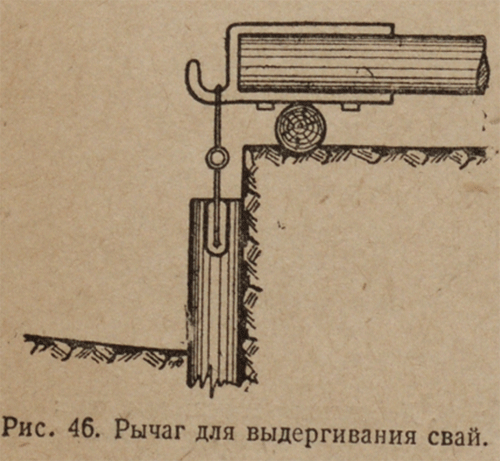
With vertical fastening and sheet piling, the spacers and pressure bars are removed gradually as backfilling proceeds, starting from the bottom: sheet piles and vertical boards are pulled out at the end of backfilling using a lever (Fig. 46). The engagement of the piles is done according to one of the methods shown in Fig. 47.

Dismantling of fastenings on piles with a wooden fence is carried out by gradual sawing as the fence boards are filled, starting from the bottom; You need to remove the fence one board at a time. The piles are removed after all backfilling has been completed in the same way as when dismantling sheet piling fastenings.
At this point in time, steel fences are used: Larsen sheet pile, steel pipes used with diameter: from 159 to 426 mm.
When carrying out excavation work in cramped conditions, as well as in the presence of groundwater, quicksand and other difficult hydrogeological conditions, when it is impossible to ensure the required slopes, it is necessary to fasten pits and trenches.
The permissible excavation depth, i.e. the maximum (critical) depth at which the slope of cohesive soil is held in a vertical position without fastening the walls, is determined by calculation. Approximate values of the critical depths of excavations made with vertical walls: 1.0 m in bulk, sandy and gravelly soils of natural moisture; 1.25 m - in sandy loam; 1.5 - in loams and clays; 2.0 - in particularly dense non-rocky soils.
The need for fastenings is determined by the design. The installation of fastenings for the vertical walls of pits and trenches requires significant costs manual labor, therefore, fastening is carried out only when it is economically feasible or when it is not possible to install slopes.
Depending on the type of soil, width and depth of excavations and service life, apply different kinds fastenings. Temporary support can be made in the form of wooden or metal sheet piles, wooden panels with support posts, panels with spacer frames. The design of any fastening includes a fence made of boards, beams or panels that directly absorb soil pressure. Purlins, spacers and other elements are used to hold the pick-up in a vertical position. A distinction is made between horizontal fastening, when the boards or beams of the pick-up are placed horizontally behind the posts, and vertical, when the pick-up boards are installed vertically and secured with horizontal purlins with spacers.
For narrow trenches 2-4 m deep in dry soils, a horizontal frame fastening is used, consisting of racks, horizontal boards or boards (solid and not solid) and spacers that press the boards or boards to the walls of the trench. Spacers are installed along the length of the trench at a distance of 1.5-1.7 m from one another and at a height of 0.6-0.7 m.
Vertical fastening is most often used if the fastenings are placed in one row. The backfill is made continuous if the soils are unstable and have high humidity, or with gaps (openings) if sufficiently stable cohesive soils of normal moisture are attached. In difficult hydrogeological conditions, when there are highly water-saturated, flowing soils, a continuous fence made of wooden or metal sheet piling is used.
To hold the pick-up in a vertical position, there are three types of fastenings: spacer, cantilever and strut. The spacer type of fastening is the most common due to its ease of assembly. In this case, the racks are freely installed at the bottom of the excavation and pressed against the intake with horizontal spacers installed at several levels according to calculations. The width of the recess with spacer fastening is limited. The spacer fastening is installed in the following sequence: after cutting off a section of the trench, two frames are lowered into it and installed on the bottom 2 m from each other, temporarily secured with guy ropes, then horizontal boards or panels are inserted from above into the gap between the uprights of the frames along both walls, after then push the spacer frames all the way.
In cases where the possibility of installing spacers is excluded (for example, when developing wide pits), anchor or strut fastenings are used. Strut fastenings consist of plank boards installed along the slopes of the racks, which are held by the struts, and stops driven into the base of the struts. However, such fastening, despite its structural simplicity, suffers from some disadvantages: such fastening constrains work inside the pit, in addition, driving in thrust anchors leads to disruption of the soil structure at the bottom of the pit.
Cantilever fastenings are characterized by the fact that the racks (wooden piles) are held by pinching the lower part into the ground. Racks, piles, rails, rolled steel, pipes, etc. are driven into the bottom of the excavation to a depth of 2.2-3.3 m. Horizontal pick-up boards are placed either behind the racks or inserted between the I-beam flanges. Cantilever fastening is carried out in the following order: along the trench laid out on the ground, racks are driven in with a calculated step to a depth below the bottom of the future pit. After this, the soil is developed. If the soil is unstable, horizontal collection elements are installed simultaneously as the trench is deepened. In this case, each subsequent board is brought from below under the previously installed one - they are grown. In sufficiently stable soils that are capable of maintaining a vertical slope for at least a short time, trenches are torn out in sections 3-4 m long to the design depth, and the pick-up boards are installed by lowering them from above - by building them up. Wooden or steel tongue and groove fastenings are widely used; with non-thrust fastening, the posts are positioned at a certain pitch, and with tongue-and-groove fastening they are driven in without intervals.
Cantilever non-thrust fastening is used for pits and wide trenches up to 4.7 m deep. If it is necessary to tear off deeper pits, additional fastening of the upper part of the racks with anchors is arranged. The anchor consists of one or two driven anchors and guys. Anchors should be driven to a depth of about 3 m and at a considerable distance from the edge (equal to approximately one and a half depth of the excavation), in order to position them outside the destruction prism. The distance between the anchors is determined by calculation. The disadvantage of this method is that the installation of anchors requires a significant free area along the excavation and, in addition, guy ropes interfere with work in this area, so sometimes guys are installed in trenches 0.5 m deep opened for this purpose.
During construction deep pits with sheet piling, first a steel sheet pile is driven along the perimeter of the future pit 4-5 m below the bottom, then anchors are installed, after which the soil is torn off. Suspended fastenings are most often used for fastening rectangular pits with a depth of up to 2-5 m, depending on the purpose; they have horizontal elements that act as thrust girders, which are suspended from a support frame laid on the surface of the excavation.
Rice. 6. :
a - console; b - anchor; c - cantilever-spacer; g - spacer; d - braced; e - suspended; 1 - shields (boards); 2 - racks (piles); 3 - anchors; 4 - spacers; 5 - struts; 6 - stops (anchors); 7 - support; 8 - ring
In loose and unstable soils, spacer or log fastenings made of plates and beams are installed. In viscous soils and with a strong influx of water, enclosing sheet pile walls made of boards or beams, reinforced with spacers, are hammered in. A wooden block frame is laid on the surface of the ground according to the dimensions of the well, and then boards 1.5-2 m long with a slight slope are driven in from the outer sides of the frame bars, close to them, and a pit is dug under the protection of the driven boards. After deepening to 1-1.5 m, a second frame of the same type is installed at the bottom of the well and a second row of boards is hammered in. Work continues in the same order until the required depth is reached (Fig. 6).
The development of trenches with vertical walls using rotary and trench excavators in cohesive soils (loams, clays) is allowed without fastening to a depth of no more than 3 m. Work on the construction of foundations, laying utility networks etc. in trenches with vertical walls without fastenings should be carried out immediately after the excavation of soil to avoid its shedding or sliding.
© 2000 - 2009 Oleg V. site™
Construction of pits and trenches with fastening
For pits and trenches up to 3 m deep, as a rule, inventory fastenings made according to standard projects. The choice of fastening type (Table 5.3) for excavation depths of up to 3 m depends on the type of soil and its moisture content.
Table 5.3
For recesses more than 3 m deep, install fastenings according to individual projects, approved by the chief construction engineer in accordance with the PPR. Constructive decisions soil fastenings are shown in Fig. 5.2.
Rice. 5.2. Constructive solutions for ground support:
a) fastening with spacers (1 - stand, 2 - bosses 3 - spacer), b) anchor fastening (1 - stand, 2 - fastening boards, 3 - screed, 4 - anchor) c) anchor fastening (1 - stand; 2 - fastening boards 3 - bosses 4 - struts) d) tongue-and-groove fastening (1 - wooden tongue-and-groove 2 - purlins) e) device for fastening trenches (1 - stand, 2 - guide 3 - sliding struts 4 - braces, 5 - steel panels) g ) device for fastening trench walls (1 - enclosing panels, 2 - spacers 3 - rod 4 - spreader blocks 5 - hinges;) h) fastening trench walls when laying pipelines (1 - wooden shield, 2 - spacer frame 3 - sector support, 4 - pipe that lowers, 5, 6 - hinge struts) e) temporary fastening when laying pipelines (1 - anchor elements 2 - soil is removed 3 - panels 4 - racks, 5 - bracket , 6 - hook)
The advantages of inventory fastenings: the ability to assemble elements, the ability to install them from above without descending into a trench, the ability to mechanize installation and disassembly, and calculate all elements for strength and stability.
Let's consider the basic labor safety requirements when making pits and trenches. The fastenings must be installed downwards as the excavation is developed to a depth of no more than 5 m (in unstable soils 0.2-0.25 m). When installing fasteners, their upper part must protrude above the edge of the excavation by at least 15 cm. The installation of non-inventory wooden fastenings for trenches up to 3 m deep must meet the following requirements: for fastening soils of natural moisture, except sandy ones, use boards with a thickness of at least 4 cm, and for sandy soils and soils of high humidity - at least 5 cm, which are laid behind vertical posts close to the ground with strengthening spacers. The fastening posts are installed at least every 1.5 m, the fastening spacers are placed at a distance of no more than 1 m, and finally the spacers are driven into the bosses. When dumping soil from excavations more than 1.8 m deep, it is necessary to install shelf-flooring on spacers, which must be protected with side boards at least 15 cm wide. When installing fastenings, fastening material must be fed into the excavation using a mechanized method. It is prohibited to dump it into trenches or pits. The condition of the fastenings must be systematically monitored. Fastenings installed in winter are inspected especially carefully and, if necessary, strengthened. Fill the holes in parts. In this case, the fastening is dismantled from the bottom up, removing simultaneously no more than three boards in stable soils, and no more than one in unstable soils. When removing boards, the spacers must be adjusted accordingly. Dismantling of fastenings is carried out under the supervision of a foreman or foreman. During construction underground structures in loose and water-saturated soils, there is no need to dismantle the fastenings, as this can lead to an accident. Usually, the recesses are filled in without dismantling the fastenings, and a corresponding report is drawn up about this.
